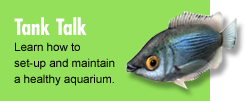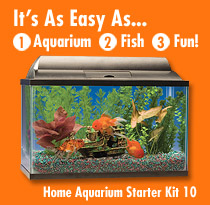Aquarium Water Problems
Here you'll find the most commonly asked questions about aquariums and fish keeping. If you don't find the answer to your question here, you can e-mail us at TetraCare® or call at 1-800-423-6458.
- Q) My water is cloudy. How can I clear the water?
-
A) The cloudiness you are experiencing is probably one of two things.
First, overfeeding your fish can cloud your water as the uneaten food is allowed to decompose. At each feeding you should feed no more than what your fish can eat in one to two minutes. Overstocking the tank (too many fish) also can cause cloudy water. Excess waste, like excess food, gives off ammonia and nitrites. You should have 1 gallon of water per 1” of (mature) tropical fish. Have 3 gallons of water per 1” of goldfish. It is best to buy the largest aquarium you can afford. The larger the aquarium, the more waste your aquarium can handle before it becomes a problem to your fish.
Second, your aquarium could be experiencing what is known as “new tank syndrome.” When you set up a new aquarium or when you carry out a large water change, it is very natural for your water to become cloudy as part of the system’s normal biological cycle. The reasons for this are fluctuations in the nitrogen cycle, and the release of gasses in solution as the result of an increase in water temperature. A water change of 50% or more will help by restarting the cycle.
Have a pet store test your water or purchase a Tetra Laborett Test Kit. High ammonia and nitrites would indicate excess food or waste. A 25% water change will bring down these levels until you can fix the problem.
Also, be sure you are providing proper filtration for your pets.
- Q) My water is green!
-
A) This is due to algae in the water. A few things can cause excess algae.
The first thing is direct sunlight on the tank. Make sure your aquarium is positioned where this can’t occur.
The next thing is excess nutrients. We suggest you have 1” of fish per 1 gallon of water. For example, a 10-gallon tank should only have 10 fish that are 1” each. More than this will elevate ammonia and nitrite levels. As a result, the algae will have plenty to feed on.
To solve the problem of green water, do a 50% water change. Scrub down the insides of the glass (but please…no soap!). Remove any artificial plants and ornaments, and pour boiling water over them. Wait one whole day, then do a 25% water change. Cut back on your feeding. Your fish should eat all the food in 2 minutes or less.
This should help get your tank in good shape. You may also buy a uv-clarifier; this will take care of the algae in no time.
- Q) My water has a very bad smell to it. How can I eliminate the smell?
- A) The first thing you should do is test your water for high ammonia and nitrite levels. A bad smell is usually a sign that excess waste is in the tank, usually excess food. To correct the problem, change out 50% of the water, wait 1 whole day, then change out 25% more of the water. Make sure when you feed the fish; they are eating all the food in 2 minutes or less. You should have 1 gallon of water per 1 inch of tropical fish. Have 3 gallons of water per 1 inch of goldfish. Make sure the water is properly filtered as well.
- Q) How much Tetra AquaSafe® do I add per gallon of water?
- A) You should add 8 drops of AquaSafe® per 1 gallon of water. For example, a 2-gallon aquarium will need 16 drops of Tetra AquaSafe®. The 3.3-ounce size has a dropper built into the bottle.
- Q) Why should I test the water in my aquarium?
-
A) In nature, waste products from decaying matter, fish waste, and other animal waste are naturally filtered. The harmful ammonia and nitrites are removed by bacteria and plant life. The substrate at the bottom of a body of water will absorb harmful chemicals like a natural filter. The actual size of rivers and lakes will keep water healthy for animals. The larger a body of water, the less lethal any harmful chemicals will be to its inhabitants. In an aquarium, the natural filtration is replaced by equipment which filters the water. The larger the aquarium you own, the easier it is the keep the water healthy. To ensure the ammonia and nitrite levels have not reached harmful levels, be sure to test the water.
To understand how filtration occurs, one needs to understand the cycle. Fish waste and other decomposing material will produce ammonia. In high quantities, this chemical will kill animals in an aquarium.
A new system will not have nitrifying bacteria present. Ammonia levels and then nitrite levels can reach deadly amounts. If this happens partial water changes will bring levels down without destroying all of nitrifying bacteria. This will only last about 4 to 6 weeks before the tank “cycles.”
Elevated levels of ammonia and nitrite should not occur in a “cycled” tank. Causes of elevated levels in a mature system would indicate overstocking, over feeding, and should be corrected immediately.




